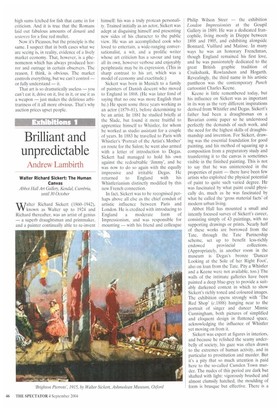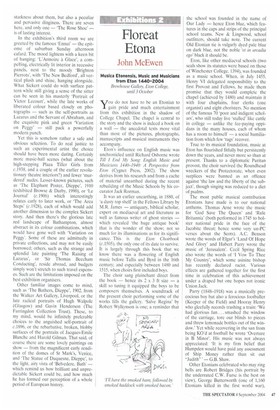Brilliant and unpredictable
Andrew Lambirth
Walter Richard Sickert: The Human Canvas Abbot Hall Art Gallery, Kendal, Cumbria, until 30 October
Walter Richard Sickert (1860-1942), known as Walter up to 1924 and Richard thereafter, was an artist of genius — a superb draughtsman and printmaker, and a painter continually able to re-invent
himself: his was a truly protean personality. Trained initially as an actor, Sickert was adept at disguising himself and presenting new sides of his character to the public view. He was an accomplished cook who loved to entertain, a wide-ranging conversationalist, a wit, and a prolific writer whose art criticism has a savour and tang all its own, however verbose and enjoyably periphrastic may be its expression. (This in sharp contrast to his art, which was a model of economy and exactitude.) Sickert was born in Munich to a family of painters of Danish descent who moved to England in 1868. (He was later fond of saying that no one was more English than he.) He spent some three years working as an actor (1879-81), before determining to be an artist. In 1881 he studied briefly at the Slade, but found it more fruitful to apprentice himself to Whistler, for whom lie worked as studio assistant for a couple of years. In 1883 he travelled to Paris with Whistler's 'Portrait of the Artist's Mother' en route for the Salon; he went also armed with a letter of introduction to Degas. Sickert had managed to hold his own against the redoubtable 'Jimmy', and he was now to do so again with the equally impressive and irritable Degas. He returned to England with his Whistlerianism distinctly modified by this new French connection.
In fact. Sickert was to be recognised perhaps above all else as the chief conduit of artistic influence between Paris and London. He is credited with introducing to England a moderate form of Impressionism, and was responsible for mounting — with his friend and colleague Philip Wilson Steer — the exhibition London Impressionists at the Goupil Gallery in 1889. He was a dedicated francophile, living mostly in Dieppe between 1898 and 1905, and exhibiting alongside Bonnard, Vuillard and Matisse. In many ways he was an honorary Frenchman, though England remained his first love, and he was passionately dedicated to the great British graphic tradition of Cruikshank, Rowlandson and Hogarth. Revealingly, the third name in his artistic pantheon was the contemporary Punch cartoonist Charles Keene.
Keene is little remembered today, but his influence on Sickert was as important in its way as the very different inspirations derived from Whistler and Degas. Sickert's father had been a draughtsman on a Bavarian comic paper so he understood perfectly the demands of such work, and the need for the highest skills of draughtsmanship and invention. For Sickert, drawing was the essential foundation for good painting, and his method of squaring up a composition from a preparatory study and transferring it to the canvas is sometimes visible in the finished painting. This is not to say that he was uninterested in the properties of paint — there have been few artists who exploited the physical potential of paint to quite such varied degree. He was fascinated by what paint could physically do, much as he was fascinated by what he called the 'gross material facts' of modern urban living.
Abbot Hall has mounted a small and intently focused survey of Sickert's career, consisting simply of 43 paintings, with no supporting drawings or prints. Nearly half of these works are borrowed from the Tate, through the Tate Partnership scheme, set up to benefit less-richly endowed provincial collections. (Appropriately, in another room in the museum is Degas's bronze 'Dancer Looking at the Sole of her Right Foot', also on loan from the Tate. Pity a Whistler and a Keene were not available, too.) The walls of the intimate galleries have been painted a deep blue-grey to provide a suitably darkened context in which to show Sickert's richly toned and coloured images. The exhibition opens strongly with 'The Red Shop' (c.1888) hanging near to the portrait of singer and dancer Minnie Cunningham, both pictures of simplified and eloquent design in flattened space, acknowledging the influence of Whistler yet moving on from it.
Sickert was expert at figures in interiors, and because he relished the seamy underbelly of society, his gaze was often drawn to the extremes of human activity, and in particular to prostitution and murder. But it's a pity that so much attention is paid here to the so-called Camden Town murder. The nudes of this period are dark but shafted with light: vigorously brushed and almost clumsily hatched, the moulding of form is brusque but effective. There is a starkness about them, but also a peculiar and pervasive dinginess. There are seven here, and only one — 'The Rose Shoe' — is of lasting interest.
In the exhibition's third room we are greeted by the famous 'Ennui' — the epitome of suburban Sunday afternoon cafard. The mood lightens with a keen bit of hanging: 'L'Armoire a Glace', a compelling, electrically lit interior in recessive panels, next to the moody 'Brighton Pierrots'. with `The New Bedford', all vertical plush and shine, hanging alongside. What Sickert could do with surface pattern while still giving a sense of the sitter can be seen in his masterly 'Portrait of Victor Lecourt', while the late works of liberated colour based closely on photographs — such as the self-portraits as Lazarus and the Servant of Abraham, and the exquisite pink and green 'Variation on Peggy' — still pack a powerfully modern punch.
Yet this is somehow rather a safe and obvious selection. To do real justice to such an experimental artist the choice should have been more daring. Certainly more music-hall scenes (what about the high-stepping Plaza Tiller Girls from c.1938, and a couple of the earlier revolutionary theatre interiors?) and fewer 'murdered' nudes. Lesser-known pictures, such as 'The Elephant Poster, Dieppe', 1910 (exhibited Browse & Darby, 1990), or `Le Journal' (c.1906) which interestingly relates early to later work, or 'The Area Steps' (c.1928), each of which would add another dimension to the complex Sickert story. And then there's the glorious late red landscape of Bathampton, almost abstract in its colour combinations, which would have gone well with `Variation on Peggy'. Some of these are admittedly in private collections, and may not be easily borrowed; others, such as the strange and splendid late painting 'The Raising of Lazarus', or 'Sir Thomas Beecham Conducting', reside abroad, and budgets simply won't stretch to such travel expenses. Such are the limitations imposed on the best exhibition organisers.
Other familiar images come to mind, such as 'The Bathers, Dieppe', 1902, from the Walker Art Gallery, Liverpool, or the late radical portraits of Hugh Walpole (Glasgow) and Gavin Henderson (The Farringdon Collection Trust). These, to my mind, would be infinitely preferable choices to the anguished self-portrait of c.1896, or the rebarbative, broken, blobby surfaces of the portraits of Jacques-Emile Blanche and Harold Gilman. That said, of course there are some lovely paintings on show — from the magnificent early rendition of the domes of St Mark's, Venice, and 'The Statue of Duquesne, Dieppe', to the light, airy vista of 'Belvedere. Bath' — which remind us how brilliant and unpredictable Sicken could be, and how much he has formed our perception of a whole period of European history.



































































 Previous page
Previous page